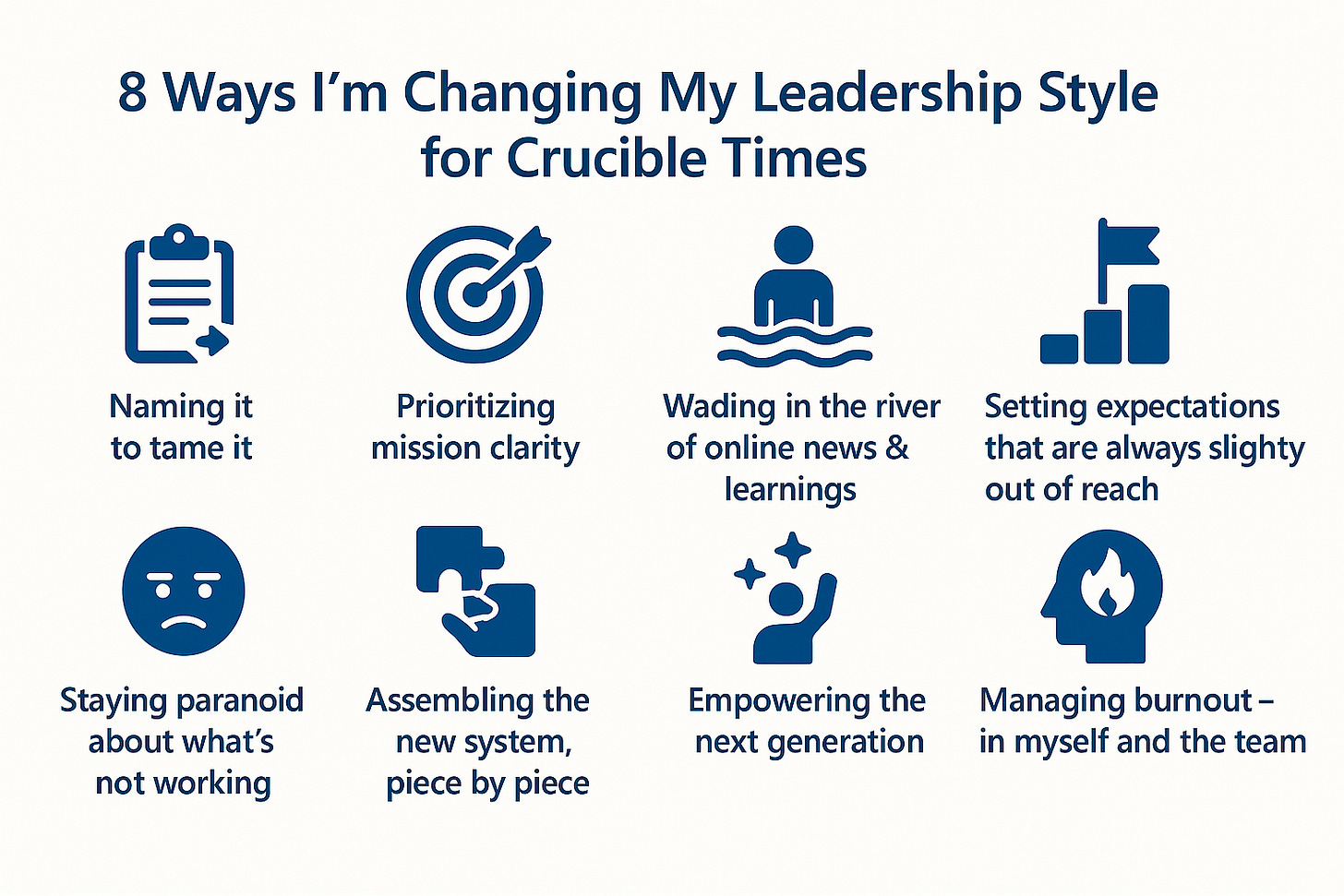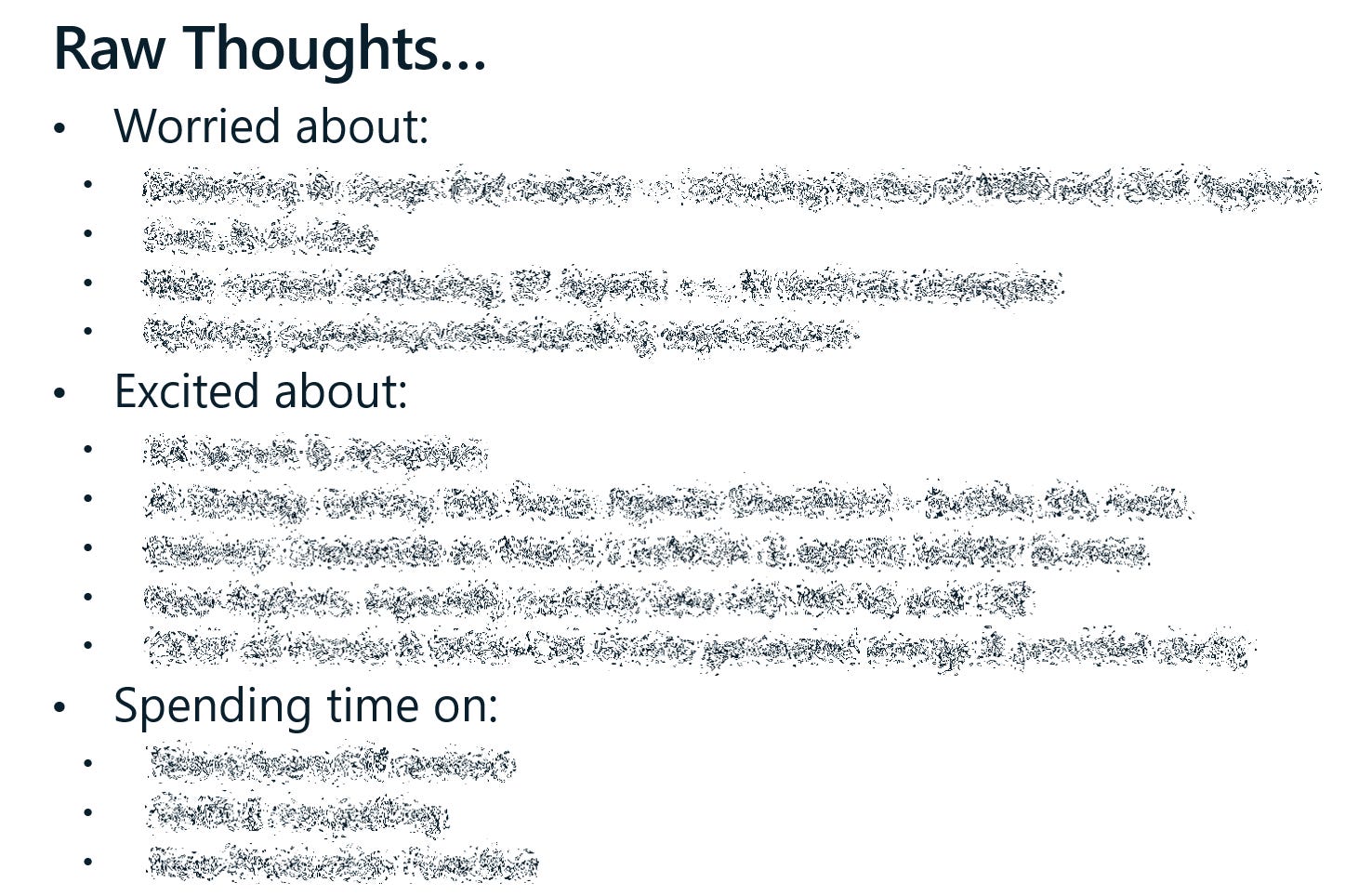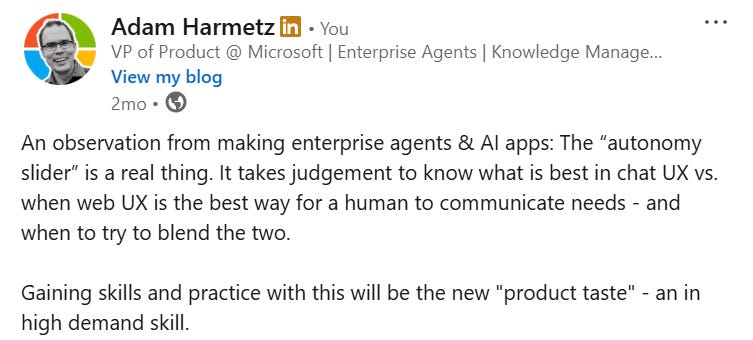🔥Crucible Leadership: How I'm Rehiring Myself as a Different Leader During Times of Great Change
Eight Leadership Behavior Changes Required to Transform an Existing Product for the AI Era
In September of 2021, I wrote a retrospective on how I led a team through the pandemic: survive-and-thrive tactics during a time of global suffering. It was one of the most popular posts that I’ve ever written.
Today, a couple years into the AI Era, I feel ready to talk about how I’m leading through what has been an even bigger change to my team and our industry.
For many of us, the current operating environment is a crucible i.e. a severe test. In the past year, we’ve mix shifted resources on the team from 20% on AI to 50%. That’s half the team producing a new type of software that we have never built before! It’s forced us to relearn, rethink, and retool our production function at the same time as we deliver immediate results to compete with high velocity, AI-born competitors. And stay excellent at the traditional web app development that we’ve been world class at! Throw in layoffs and a return to office mandate that is upending the contract between company and employee across the industry - and we have a full cocktail of operating environment changes.
I know many product leaders feel this exact same angst - maybe you do too! What defined mastery in our profession has changed. I don’t feel like an expert yet, but we have missions and mandates that requires us to perform as experts immediately.
If your job as a product leader this year feels extra stressful, tricky, and prone to imposter syndrome, you are not alone. Read on for my approach on how to rethink leadership during times of change.
Fire & Rehire: An Andy Grove-ism.
One of my favorite stories in the history of tech is how Andy Grove at Intel responded to a changing business environment. Intel’s original product was memory chips and Japanese memory companies were dumping cheap chips on the US market. It was clear that Intel’s entire business needed to change, which lead them to pivot to making CPUs.
Andy Grove realized it wasn’t just the business that needed to change - how he showed up as a leader and the entire culture of the company needed to shift in order to transform from low-cost commodity to high performance computing. As this came into focus, he famously fired himself, physically walked out of his office door, and walked back in with intentionally on how he was going to lead differently.

Navigating the Crucible: Eight Behavior Changes
So what’s my version of walking out and walking back in? I’ve had some time to think about and test a few strategies for what this moment calls for - and I’ve landed on eight behavior changes that I’m holding myself accountable to.
I am naming it to tame it.
One of the biggest tensions of this era is that existing systems weren’t designed for the new environment. It’s important to name that - it provides the motivation for non-linear work. For example, at a recent extended leadership team meeting, I spelled out my worry list, the problems requiring my personal energy, and a list of things that need to change. I got more unsolicited praise for that format of XLT meeting than any other I’ve done in 2025 - people are hungry to see leadership name what’s broken.
I am prioritizing mission clarity.
People are scared - they see promises of AI redefining the different categories of software that exist and they are questioning the longevity of their teams and job. So, I’ve leaned in even more than normal into mission clarity - at the macro level, this means writing down our products’ role in a new world and our core thesis for differentiation. At the micro level, this means creating space for more single-threaded “squads” with a clear single mission and mandate.
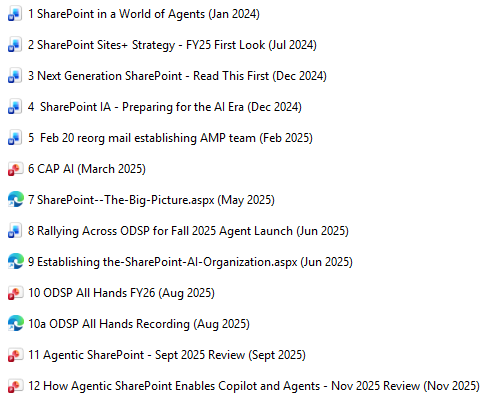
I’m wading in the river of online news & learnings.
Social media is the “town hall” of product making & AI news right now - engaging online is table stakes for me as a product leader. Contributing to the conversation is a way to practice brevity and synthesis, and consuming enables me to guide the team towards the latest trends. This is one reason why I upped my LinkedIn presence recently - but X, Substack, and tech podcasts are all critical right now.
I am setting expectations that are always slightly out of reach for the old way of doing things.
This one is critical to the transformation of an existing team - either we set the new bar for excellence, or it gets sets by others (execs above us, competitors, other stakeholders). I know my personal trainer at the gym uses the same philosophy because it creates growth. For example, earlier this year, I created a very busy September for a particular part of the team - a series of aggressive strategy and product reviews that in normal times I would have let spans 2-3 months. But I felt it was important to set a new anchor point, inspiring the team to find creative ways to meet the new bar.
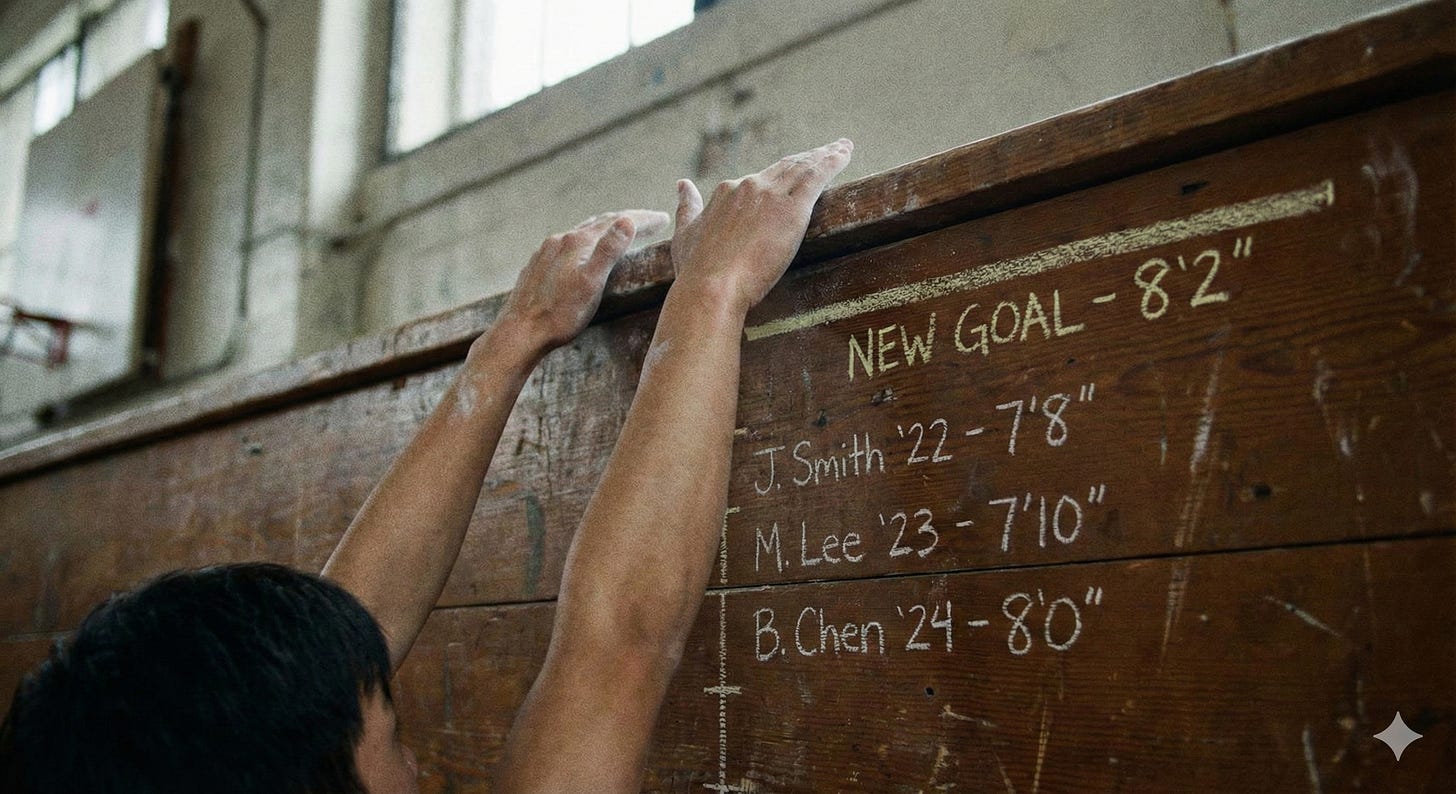
I am staying paranoid about what’s not working.
As leaders, we all decide how much time to spend on problem identification vs. problem solving. During times of change, it’s important for senior leaders to shift the spotlight more to problem identification - asking the team to “bring me problems,” injecting the right amount of entropy to see if plans hold up to questioning, and finding comparisons that expose underthinking. Momentum and consistency are much less important now - that’ll come in the growth stage. This works best when you have an LT (like I do!) who can run the team, leaving me to focus on what might be missing vs. reviewing plans. (Think XO and Captain vibes). Another Andy Grove-ism: “Only the paranoid survive.”

I am assembling the new system, piece by piece.
At Microsoft, we are calling the new way of building product the new “production function.” AI-born startups get the luxury of starting from the latest first principles; we have to retool an already at scale system. This has increasingly become more of my job - weekly x-company meetings on AI accelerators, incorporating Applied Science into the mix, ensuring new aspects of product making like vibe coding prototypes and rigorous AI evals are deployed. Systems thinking about the production function here creates a sense of order in the chaos.
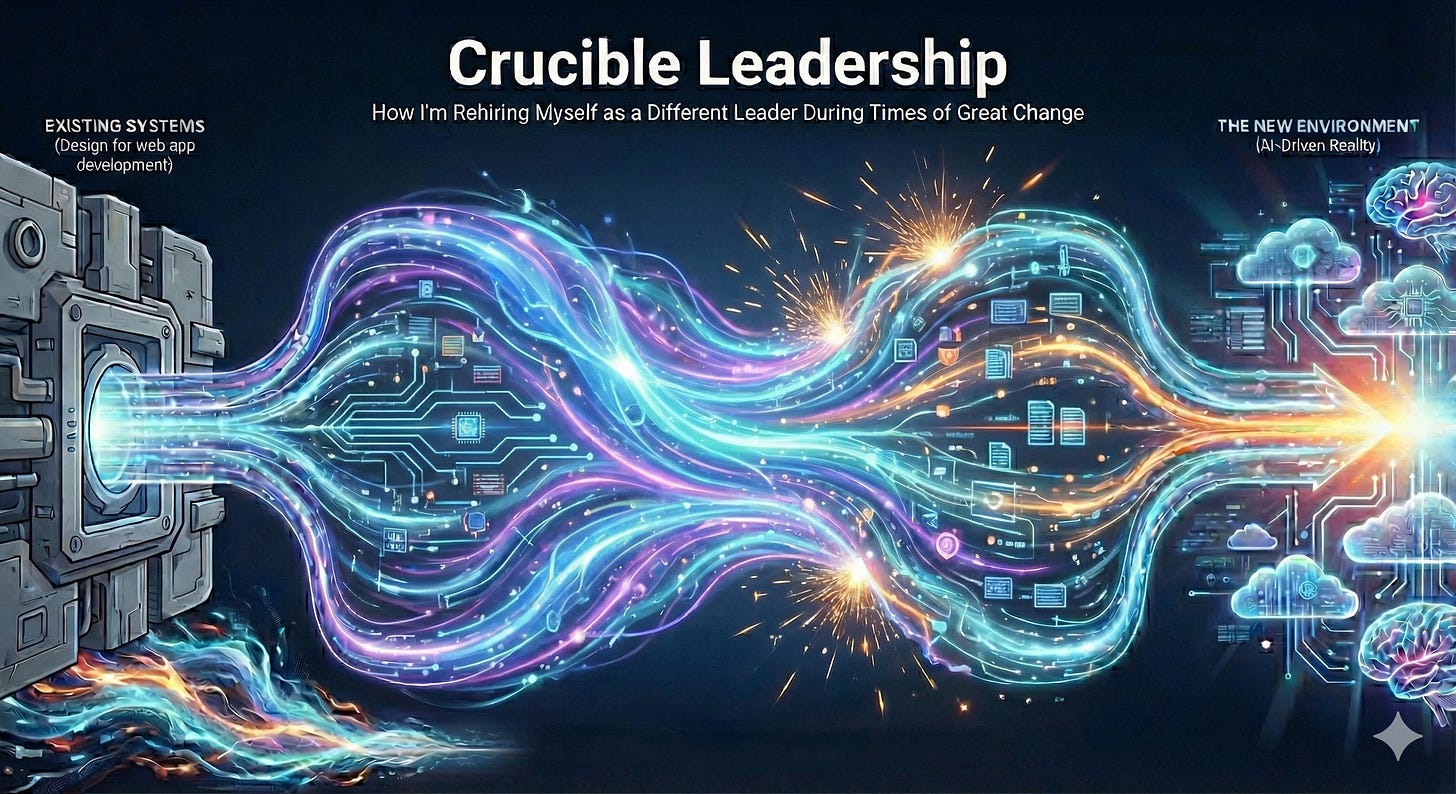
I am empowering the next generation.
I distinctly remember in the early days of the cloud transformation a decade ago, my org leader asked me - an up-and-coming frontline manager at the time - to take point on the strategy for continuous delivery of our cloud software (vs. our 3 year on prem release cycles). Crucibles are a great time to reach out to every level of the organization to solicit ideas and empower solution building. It’s not like the top of the hierarchy has it all figured out anyway!
I am managing burnout - in myself and the team.
My pandemic post on leadership framed this balance between boredom and burnout - the COVID crisis saw people on both sides of the spectrum. The AI transformation is overweighted to burnout - look at my list above: naming what’s broken, relentlessly higher expectations, and paranoia around unknown unknowns. So, I’m watching myself and my team - ensuring we get good breaks to recharge, practicing self-care, and doing what I need to ensure I bring my best self to work.

A New Hope: It’s All A Repeating Cycle
The good news about 2025 - we’ve been here before. The industry is a repeating cycle of technical shock, category recreation, product/market fit, and scale. And while the early stages are more stressful than average for existing products, it’s a well-worn path. And it gives me deep purpose to build resilient software that customers can trust, and an operating environment that adapts so people can do career defining work.
Onwards to the new era!


